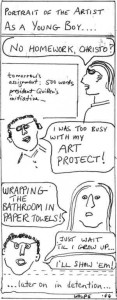Essay by Reggie Morton
Judgment – October 2006 – Colorado Central Magazine
“Perfection is the enemy of the good.”
I don’t regularly go around quoting Voltaire, mainly because I know Jack about him aside from this one blurb that I found while looking for something else. But the idea implied seems worth discussing among intelligent folk, and even old drunken Indians like me.
Example: I used to frame regular nuthin’ special houses like I was building furniture; it pissed off most of the people I worked with, and I didn’t really care whether it made a difference to customers. To me, getting as close to perfect as possible was the only possible way to do things, and it burned my gut to always be chasing the unattainable, perhaps even fictional. The only balm I could come up with was deriding my critics for not having any “pride.” After years of hearing “we’re not buildin’ a damn piano,” someone finally gave me a Steinway Construction ball cap.
I don’t build houses for other people any more, thank gawd — just sit on me arse and draw them. A few years ago, My Dear Wife came up with this decrepit 1893 house that she knew I couldn’t resist because it was way up in my beloved Colorado, just a short Jeep ride from my High Country place.
I’d seen the house sitting here on ride-bys over the past half-century, and usually thought something along the lines of “cool, looks like a helluva lotta work.” When I looked the crooked thing over carefully, with owning it almost a foregone conclusion, I knew that my life was about to change radically. It has, and I’m a little surprised to be feeling OK about it.
There’s no way to really straighten this place out, short of complete demolition/replication, so things just have to be “fixed” in a context appropriate manner. Doors that were an inch out of square just get re-done to work and creatively trimmed to hopefully create an illusion likening to perfection …from certain perspectives… when the light is right. Rolling floors get soft carpet with triple pad in spots instead of gleaming, straight-line hardwood. Siding is neither evenly spaced nor level, but carefully averaged to meet what’s there without glaring inconsistencies from maybe twenty feet away.
I learned while installing new windows that a small thing level and plumb placed in a big crooked thing will itself appear more crooked than the big thing — catch 22-1/2.
Out of survival necessity, I’ve begun to embrace this illusion thing — that is, taking the side of good over perfect, and I no longer necessarily see it as dishonest or superficial. My gut is better for it, and nobody complains about the way I work. Better yet, I no longer desire to judge anyone else — even the #*!*ed idiot carpenters who built this *&**!!ed thing.
Heck, sometimes I make a little wiggle in a thing, just to have something to remember it by. I look around the room and my eye stops on a piece of trim that I made a little goofy. I smile at the recollection of why I did it that way, while completely forgetting the other pieces that I made “perfect.”
My engineer friends like to remind me that the real goal of work is not perfection but robustness. That is, any system (engineers call everything from wire to sex a system) is most functional when its design tolerances allow likely errors to occur without serious consequences to operation. I read somewhere about a German WWII weapon that was so beautifully precise in its specification and manufacture that it utterly failed in the field when the operator tried to maintain it in a mud trench. I’ve had cars like that, but I’ve also had some that failed because they were just sloppily built (my present vehicle comes to mind).
It’s a comfort to find, even so late in life, that cutting ourselves a bit of slack might not be such a terrible thing. Sorta makes me want to offer sage advice to whippersnappers who would probably and perhaps rightly dismiss me as someone lacking “pride.” Or maybe I’m just trying to justify getting old and sloppy.
Reggie Morton lives in, and constantly works on, the old Yellow House in Maysville.


